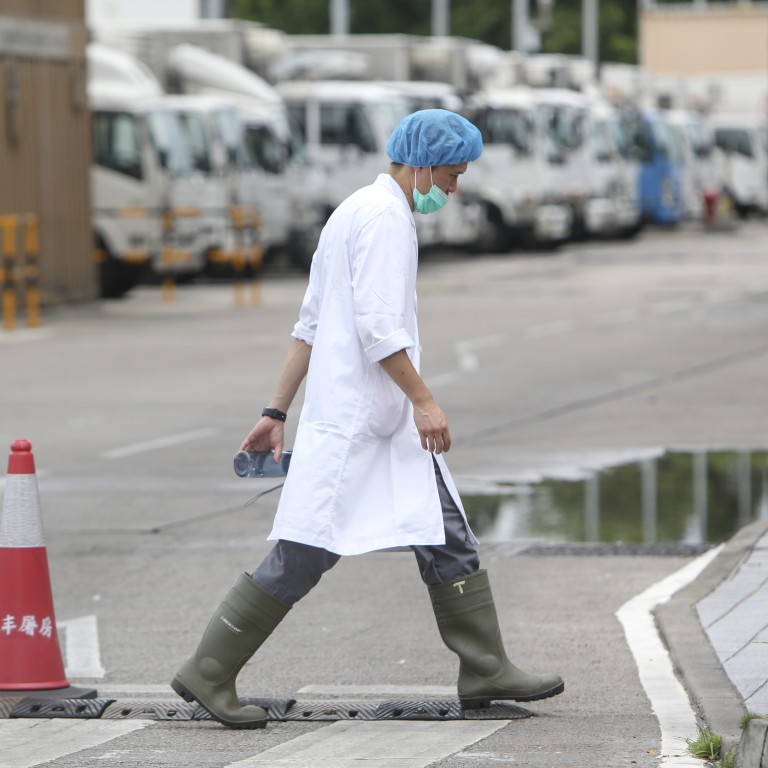
African swine fever returns to Hong Kong, hitting city’s pork supply and leaving consumers counting cost of pricey meat
- Latest case discovered in Sheung Shui slaughterhouse with 4,700 pigs needing to be culled
- City’s largest abattoir will be out of action for four days with price of pork soaring as supplies dwindle
The Hong Kong government has been urged to come up with a sustainable policy to handle African swine fever, after the sudden shutdown of a slaughterhouse on Saturday dried up supply and left consumers paying over the odds for pork.
The discovery of a second case of the disease on Friday night meant health authorities could cull 4,100 pigs at the premises in Sheung Shui, which along with any subsequent sanitation, should take four days.
A lawmaker and some butchers said the closure of the larger of the city’s two abattoirs twice in about a month had cost taxpayers tens of millions of dollars, while the problem kept returning.
“Hong Kong should immediately stop importing any pigs from mainland China, which has been the source of the infection so far,” said Helena Wong Pik-wan, a Democratic Party lawmaker.

“Hong Kong taxpayers are not an automatic teller machine, which the government has drawn HK$20 million from to compensate pig farm owners for culling 6,000 pigs the last time. This time we expect the bill to be about HK$18 million.”
Shoppers, butchers and pig owners were caught off guard on Friday night when Secretary for Food and Health Sophia Chan Siu-chee revealed the virus had been detected in a dead pig at the government-owned facility.
She said the slaughterhouse, which accounts for 80 per cent of the city’s pork supply, would shut down for the second time in a month. The last shutdown took place from May 11 to 18, during which 6,000 pigs were killed.
The disease is not harmful to humans, but deadly to pigs. A huge outbreak of African swine fever in mainland China has resulted in more than a million pigs either dying from the disease, or being culled since last August.
Deadly in pigs but harmless to humans, why is African swine fever such a threat to China’s economy?
The latest dead animal in question had been imported from a farm in Meizhou city of Guangdong province, on May 25, the Food and Health Bureau said on Saturday. At that time, it did not show any symptoms of the disease, and health authorities were investigating the case, it added.
The earlier case was found in a pig imported from Zhanjiang in Guangdong.
Wong said Hong Kong’s health authorities must step up inspection and quarantine work as efforts on the mainland left much to be desired.
After an hour’s meeting with industry stakeholders on Saturday, health chief Chan said the number of pigs to be culled would be 4,100 instead of the 4,700 estimated on Friday night.
She said the Hong Kong and mainland authorities had thorough processes in place for the inspection and quarantine of infected pigs before they enter city.
"Those found with the virus at the border, will not be exported to Hong Kong,” the health boss added.
"We also have veterinarians who are in charge of spotting pigs with symptoms of the disease and will take action."
South Korea braces for deadly African swine fever outbreak after cases reported in the North
Chan Kin-yip, the chairman of the Federation of Hong Kong Agricultural Associations, said no compensation could make up for their loss and money meant nothing if the mass culling of the animals kept on happening.
Chan, of the association, demanded the mainland and Hong Kong authorities improve the quarantine inspection process. Calling for a faster response to incidents, he said in the latest case “infected animals were allowed to spread the virus, innocently affecting thousand of others at the slaughter house”.
An entrepreneur surnamed Yau and his wife, who run a butcher’s shop at the Tai Po Hui Market, said their stall Pang Kee would be forced to close for business for 12 days over the past month.
“We suffer so much, can the government come up with a more comprehensive policy to deal with the swine fever issue and minimise the impact on us and consumers?” Yau’s wife said while preparing to close again, this time until Tuesday.
“We still have to pay rent and utilities while the store is closed.”
The couple want the government to impose temporary relief, such as waiving the rent at their 200 sq ft store for a month. There are about 25 pork butchers in the Tai Po Hui Market.
Shoppers felt the pinch as the cost of meat soared, with fresh pork costing 28 per cent more at HK$90 per catty (600 grams) at a butchers in Tai Po Hui Market, which was selling Friday’s stock.
“It was all snapped up within a couple of hours,” said a butcher surnamed Chan, who was closing the shop for the day at about 9.30am.
“Even if there is new supply tomorrow, it will be even more expensive. We have ordered some stock from the other abattoir but the wholesale price is HK$1,000 more at HK$3,800 [per 100 catties], which is 35 per cent higher.”
The city’s fresh pork supply will rely on the smaller of the city’s two abattoirs, Tsuen Wan Abattoir, which on average can handle 400 pigs a day.


